ROME HISTORY.
1. THE MONARCHY
1. 1. The founding of Rome.
Rome was founded in 753 BC in the centre of the Italian Peninsula, a strategic territory between the eastern and the western Mediterranean area.
At the beginning of the eighth century BC this territory was inhabited by different people:
- The Etruscan in the north and centre.
- The Latins in Latium, in the centre.
- The Greeks in the south, in Magna Graecia.
According to the legend Rome was founded by Romulus and Remus in the place where they were born. They were taken and nursed by a wolf. In fact, in the mid-eighth century some tribes of Latin origin settled around the hills near the river Tiber because of:
- protection provided by the river and the hills.
- strategic location for trade, which linked the peninsula's northern and southern territories.
We can distingish three periods into the Roman history:
- Monarchy (753 BC-509 BC)
- Republic (509 BC-27 BC)
- Empire (27 BC-476 AD)
1. 2. The monarchy:
In the beginning Rome was an absolute monarchy, but the king was given advice buy the senate an assembly composed of representatives of the patrician families.
There were seven kings: four Latins kings and three Etruscans. Etruscans occupied Rome during the sixth century BC. Etruscan domination ended in 509 BC when Tarquin the Proud was expelled after a revolt.
Economy: agriculture and cattle-raising.
Society was divided into two groups:
patricians, descendants of the first inhabitants of the city. They were considered citizens and controled most of the land.
plebeians, free people. Had no political rights but had to pay taxes and fight in the army.
2. THE REPUBLIC (509-27 BC).
2. 1. The republican form of government:
- Comitia or voting assemblies:
- Members:Roman citizens
- Duties: Passed laws, elected magistrates and decided about war and peace.
- Senate:
- Members:300 members, who were former magistrates.
- Duties: Approved laws, Controlled magistrates, Decided on foreign policy.
- Magistrates:
- Members: They were elected each year. There were praetors, censors and quaestors.
- Duties: Controlled the government.

2. 2. The fight over political rights:
Roman society was divided into two groups:
- Patricians: the oligarchy.
- Plebeians: The common people.
Origin of the conflict:
At the beginning of the Republic the plebeians paid taxes but had no access to political post, just the patricians could have them.
The conflict: for more than 200 years the plebeians fought to have equal political rights, they finally succeeded un the third century BC.
2. 3. Major conquests during the Republic:
During the Republic, Rome began to expand territorially with the help of a very well disciplined and organised army.
Phases of this expansion:
- Domination of the Italian Peninsula: completed by the mid-third century BC.
- Control over the western Mediterranean: Figthings against Carthage, the three Punic Wars.
- Control over the eastern Mediterranean: They confronted Greece and the Hellenistic monarchies.
- Control over all the Mediterranean area: Conquest of Egypt, 30 BC. They call it Mare Nostrum.



Consequences of the expansion:
- Positive: The conquests provided raw materials, land and people.
- Negatives:
- Social crisis:
- The powerful class profited most from the conquests, receiving large plots of land and buying slaves.
- Peasants farmers were ruined because they had no serve in the army and could not compete with large landowners.
- Political crisis: Civil wars started between the generals who wanted power. In 48 BC Julius Caesar was made dictator for life. Julius Caesar

The Republican Army:
- The basis of the Roman army, the legions. Formed from between 4,200 and 6,000 soldiers and 400 on horseback. The backbone of the legion was the foot soldier, the legionaries.
- The evolution of the army:
- During the Republic, all Roman citizens had to serve in the army. The soldiers receive no salary and had to take their own weapons.
- In later times, there was a permanent army with professional soldiers. The state pay them and provide them with weapons. Roman legionaries

Roman legionary.

3. THE ROMAN EMPIRE (27 BC-476 AD)
3. 1. The Empire´s system of government:
After Julius Caesar´s death there was a civil war that ended with the triumph of Octavio Augusto, his nephew. In 27 BC the Senate granted him practically complete power, instituting a new form of government, the Empire. The institutions of the Republic and the Senate continued to exist but under the control of the emperor.

3. 2. The Pax Romana.
The Pax Romana was the period between the first and the second Century AD. The Empire reached its maximum expansion and enjoyed peace inside its borders. The Romans divided the Empire into provinces under the rule of a governor. Under emperor Trajanus the fronters reached the British Isles, the rivers Rhine and Danube, the Caucasus and the Tigris, and the Sahara desert.
3. 3. Romanization:
As the Romans conquered, they introduced Romanisation, the process through which the conquered people, the barbarians, assimilated the culture of the conquerors. The instruments of Romanisation were: the towns, The Latin language and the roads.

3. 4. The crisis of the third century:
During the thrid century took place a political, economic and social crisis that almost destroyed the empire:
- Political crisis:
- The Roman legions suffered their first defeats by the Barbarians, the frontiers were no longer safe.
- The military chiefs began to have control over the emperor.
- Economic crisis: As the conquest ended there were fewer slaves to work and agricultural and mineral production, and commerce dropped, as a consequence the Empire became poorer.
- Social crisis: Taxes increase and this caused migration from the towns to the country, as a consequence the Empire became ruralised. In 260 AD, the roman army was defeated by the persians who captured the roman emperor Valerian

3. 5. Division of the empire and fall.
In order to improve the administration, Theodosius I divided the empire in two parts:
- the Western Roman Empire with capital in Rome
- the Eastern Roman Empire wih capital in ConstantinOple, richer and with more population.
Finally, in the 5th century, the germanic peoples invaded the Western Empire and in 476 AD, the last roman emperor, Romulus Augustulus was deposed.

4. THE ECONOMY
4. 1. Slavery:
The Roman economy was built on slaves, on the generalised use of slaves to work in agricultural and urban activities.

4. 2. Agriculture.
- Agriculture was the main economic activity and it was based on the farming of the three Mediterranean crops: cereals, vines and olive trees.
- The Romans introduce the “aratrum” or crooked plough throughout the Empire.

- Division of the land:
- Small properties cultivated by their owners
- Large estates, “villas”, worked by slaves which were divided into two parts:
- The lord house in the centre of the estate, luxurious and richly decorated, with mosaics and statues.

- Storehouse, barns, furnaces and all kind of workshops to cover the needs of the large agricultural landowner
4. 3. Farming: Based on sheep, goats, donkeys and horses
4. 4. The mining industry and crafts:
- Mining was an important activity in the Empire. Many minerals were found; gold, silver, iron, coal and tin. The mines belonged to the state, which rented them out to individuals. The workforce was all salves.
- Craftwork developed considerably. There were large workshops with slaves, or in smaller workshops where the members formed associations to defend their own interests
- Food processing was very important: oil, wine and salted fish.
5. ROMAN SOCIETY
The roman society was divide into two main categories:
- The citizens:
According to the political rights were divided into two groups during the Monarchy and the Republic: plebeian and patrician.
Later during the Empire they were divided according to their wealth:
- Honestiores that were the wealthiest.
- Humiliores, plebeians with a low social status, both in the city and the country.
- The non-citizens: people who had no right to citizenship:
- Conquered populations until 212 AD, when they were granted citizenship.
- Foreigners that came from outside the Empire. Most of them were traders or artisans.
- Freedmen, slaves that had been freed by their owners.
- Slaves, they had no rights. They were war prisoners, people who could not pay their debts and slave's children.
6. ROMAN RELIGION AND CHRISTIANITY
6. 1. Roman gods and worship.
There were two kinds of religion.
- Private religion:
Took place within the family. They worshipped:
- The Lares and the Penates, household gods
- Manes, the spirits of ancestors.
In every house there was a Lararium: a domestic altar, where the head of the house, the “pater familia”, made offering.

- Official religion:
Based on the worship of the gods and, from the first century AD onwards, on the worship of the Emperor. After the conquest of Greece the Roman gods were assimilated with the Greek gods. Romans were very tolerant, they incorporated the gods of the conquered people into the Roman pantheon.
6. 2. Birth and expansion of Christianity:
The birth of Christianity:
It had its origin in the first century in Palestine. It was a new religion preached by Jesus of Nazareth:
- A Jew born in Bethlehem in the time of Augustus.
- He claimed to be the son of God.
- With his disciples, the apostles, he preached around Palestine a message of equality and love for one´s neighbour.
The expansion of Christianity in the Empire:
Christians persecution:
In the early years they were persecuted by the authorities because they refused to worship the Emperor due to their monotheism. Christians had to practice their rituals secretly.
Edict of Milan, 313: the Emperor Constantine authorized Christians to practice their religion.
Edict of Thessalonica, 380: The Emperor Theodosius declared Christianity the official religion of the Empire